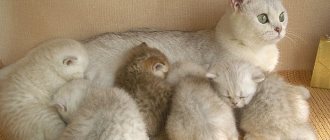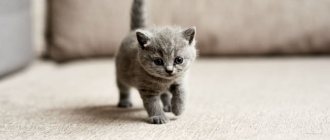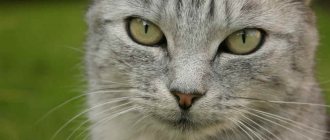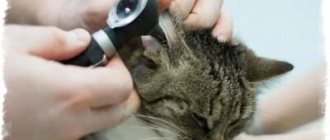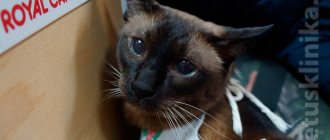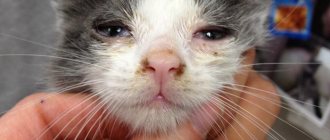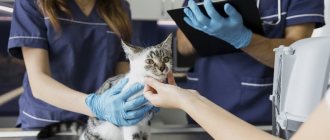Causes of cleft palate
An acquired defect occurs as a result of injury. Congenital pathology appears during intrauterine development: the halves of the palate do not fuse together. According to statistics, this disease most often affects cats and dogs with wide, flat faces (brachycephals).
Unfavorable factors responsible for the manifestation of the defect:
- The kitten's father and mother are close relatives;
- genetic problem in the animal's parents;
- the cat suffered an infection during pregnancy;
- the kitten's pregnant mother was taking medication;
- diabetes;
- X-ray exposure in the prenatal period;
- poisoning during pregnancy;
- avitaminosis;
- adverse environmental impact.
Types and symptoms of the disease
The clefts in the mouth run strictly in the middle of the palate. Degree of manifestation of the disease:
- Hidden cleft palate - a cleft that affects the muscle layer of the soft palate or the bone of the hard palate. The development of the mucous membrane is like that of a healthy animal.
- Incomplete cleft palate - the separation of the halves does not reach the border of the hard palate.
- Full cleft palate – the cleft continues to the upper front teeth.
Kittens and a puppy with a cleft palate have difficulty eating. The milk exits through the nasal opening and enters the respiratory system, causing hypoxia (chronic lack of oxygen) to develop. Food debris accumulates in the nasal passage and leads to the development of infection. Sick puppy, kitten:
- does not gain weight well;
- breathes with an open mouth;
- lethargic, weakened, inactive;
- coughs and sneezes while eating.
Sutures are placed on the mucous membrane of the ventral wall
Then it is sutured from the side of the oral cavity
What measures should the owner take?
Cleft palate is a problem that requires mandatory surgical intervention. Since the kitten is too small, it is necessary to raise the baby until it reaches a weight of one kilogram. The owner will have to transfer the animal to artificial feeding through a pipette, since the pet cannot feed itself. Surgery involves suturing the palate (mucous membranes). During the postoperative period, the cat must be closely monitored, since damage to the sutures during feeding is possible. In this case, repeated surgical intervention will be required. After the stitches heal, the animal will be able to eat properly and lead the normal life of a domestic cat.
Stitches in a week
In 2 weeks
In 3 weeks
Lentigo
The most common cause of black spots in a cat's mouth is increased pigment formation. Sometimes kittens are born with small spots, which become more noticeable as they grow older. These dark marks are called lentigines and their appearance is not dangerous for furry pets. However, stains with this defect should not:
- itch;
- protrude above the surface of the skin and mucous membranes;
- have a rough surface;
- peel off.
Most often, lentigo occurs in red or tortoiseshell cats.
Cleft lip in cats
A cleft lip is a developmental anomaly in which the upper lip of an animal is divided in the middle by a wide gap. The edges of the cleft are smooth, without inflammation. This defect often accompanies another pathology - cleft palate.
Causes of cleft lip
A cleft in the middle of the upper lip is formed in a cat as a result of improperly fused primary palate.
Factors influencing the occurrence of cleft lip:
- genetic predisposition. The presence of ancestors with a cleft lip in the pedigree of an animal indicates a high probability of recurrence of the defect in the offspring;
- damage to the fetus during the mother's pregnancy (stress, trauma, poisoning, radiation);
- belonging to breeds that are at risk for this disease (Ragdoll, Persian ultratypical);
- excess retinol (vitamin A) in the diet.
The development of a cleft lip in a pet may be accompanied by other serious diseases: acrania (cranial bones do not fuse), colon stenosis, enlarged myocardium, and spinal cord agenesis.
Photo of a kitten's cleft lip
Treatment of cleft lip
A defect of the upper lip in cats does not prevent the animal from leading a full life and therefore does not require treatment. At the owner's discretion, the operation can be performed for cosmetic purposes. Surgical intervention is carried out after examining the animal’s cardiovascular system in order to eliminate the risk of negative effects of anesthesia. During the postoperative period, the animal should be fed exclusively soft food and careful attention should be paid to ensure that the cat does not damage the sutures while eating. After the stitches are removed, the animal is completely healthy, the pet can be transferred to a standard diet. Preventive measures to prevent the anomaly: a balanced diet.
Symptoms of calcivirosis
The main symptoms of calcivirosis are:
- nasal congestion in a cat;
- sneezing;
- purulent or clear discharge from the eyes and nose;
- ulcers on the palate, gums, tongue, lips;
- increased salivation.
In rare cases, calicivirus is accompanied by symptoms such as:
- conjunctivitis;
- fever;
- lethargy;
- increased body temperature;
- depression;
- decreased appetite;
- decreased or absent sense of smell;
- squinting of eyes;
- swelling of the paws and muzzle;
- enlarged lymph nodes;
- jaundice.
Signs of the disease can vary greatly in each clinical case, since the calcivirosis virus has many strains. Sometimes the only sign of the disease is mouth ulcers. In other cases, with calcivirosis, the cat begins to limp. Joint lesions from the calcivirosis virus are more common in young cats.
Cat's breath odor
Since a cat cannot complain about a health problem on its own, monitoring symptoms is important for diagnosis. Bad breath from your pet (halitosis), which can occur occasionally or be present all the time, can alert you to the presence of problems.
The causes of the symptom are classified depending on the age of the pet. An unpleasant odor can be caused by:
In the age group up to one and a half years:
- replacement of milk teeth with permanent ones;
- injury;
- hit by foreign objects.
For adult pets from two to eight years old:
- infections of the larynx and oral cavity;
- dental diseases (caries, dental plaque, tartar);
- insufficient hygiene measures for cleaning the oral cavity;
- diseases of internal organs;
- swelling in the oral cavity;
- low quality food.
In older animals after eight years:
- all reasons characteristic of middle age;
- diseases of the endocrine system (diabetes);
- chronic diseases of internal organs.
Photo - black palate of a British cat
Read more about the reasons why your cat's breath smells
- Changing teeth. The growth of permanent teeth may be accompanied by short-term inflammation of the gums. Visually, the problem is determined by the presence of redness on the gums. No medical intervention is required except in rare cases when the new tooth fails to erupt and forms an abscess inside the gum.
- Diet. Domestic cats may covet food from the table or from the trash can. Cheap dry food made from poor quality ingredients can also lead to problematic odors.
- Foreign objects. In search of a toy, a cat is capable of chewing dangerous objects (small bones, rope, wood chips). The debris gets stuck in the crevices of the dentition and injures the oral mucosa.
- Bacterial or viral infections (rhinotracheitis, calicivirosis). Infection of the oral cavity is accompanied by the flow of saliva, the occurrence of ulcerative lesions of the mucous membrane, and an increase in temperature.
- Dental diseases. Dental diseases (caries, pulpitis, tartar) are necessarily accompanied by an unpleasant odor from the pet’s mouth, as a consequence of the pathogenic process.
- Lesions of the salivary glands. Improper functioning of the salivary glands leads to excess or lack of saliva. Insufficient saliva production causes dry mouth and damage to the internal surfaces of the oral cavity due to friction during eating. Increased salivation leads to wet hair on the chin. In a humid environment, microorganisms begin to actively multiply, which provokes the appearance of odor.
- Tumors in the mouth lead to soft tissue decay and bleeding. These processes are also sources of unpleasant odors.
- Damage to internal organs leads to changes in the composition of exhaled air. Diseases of the urinary tract are indicated by the smell of ammonia (very stinking), problems in the gastrointestinal tract will make themselves felt by the smell (stench) of rot.
- If hygienic treatment of the oral cavity is neglected, dental plaque occurs, which manifests itself as an unpleasant odor from the mouth.
Types of odors
Based on the type of odor from your pet's mouth, you can determine the cause of the problem:
- The smell of rot and rotten food (smells like putrid fish or rotten meat) occurs due to problems with the digestive system, constipation or worms.
- An ammonia “aroma” indicates kidney problems.
- If your cat's breath smells like acetone or fruit, your pet will develop diabetes.
- The smell of acid indicates high acid content inside the stomach, a predisposition to peptic ulcers, or that the cat has recently vomited.
- If an animal's mouth smells like feces, the contents of the intestines are thrown back into the stomach.
What actions should you take if your cat has bad breath?
The smell from the mouth of an animal is a serious problem, since it indicates disturbances in the normal functioning of the body. What to do, how to treat? First of all, the owner should seek advice from a veterinarian. In addition to this, the pet owner can take the following measures:
- Sores or scratches in the mouth are treated with an antiseptic. A veterinarian can help determine the cause of this symptom. Additional treatment with antiviral drugs may be required.
- Plaque is removed by oral hygiene. To do this, you need to purchase animal teeth cleaning products from a veterinary pharmacy.
- You can remove foreign objects yourself if the objects are not stuck too deeply.
If the initial examination does not reveal the cause, you should contact a veterinarian immediately!
Folk remedies
- Black spots on a cat's lips can be wiped with a decoction of yarrow.
- A decoction of celandine helps well. They wipe the affected areas and make lotions.
- Some people treat acne in animals with pumpkin. To do this, take a fresh pumpkin cut and smear the dots with it. The procedure must be repeated three times a day. Each time you need to use a fresh cut.
- A decoction of calendula with chamomile flowers, mixed with two tablets of furatsilin, has worked well. It is recommended to use the product twice a day.
You can also treat black spots on a cat's face with chlorophyllipt or clotrimazole 1%. The products are not rubbed in, limited to spot application. Sulfur ointment is applied over the drug.
Treatment with any drugs or agents should be discontinued in the following cases:
- Skin irritation is visible. To treat black spots around the cat's mouth, you need to wait until the skin heals. After all, you can only influence the entire cover.
- Expansion of the area of the rash. This indicates the ineffectiveness of treatment.
- Acne disappeared due to recovery.
Sources
- Corsino CB, Ali R, Linklater DR. Herpangina. 2021 Jun 23. In: StatPearls [Internet]. Treasure Island (FL): StatPearls Publishing; 2020 Jan–. PMID: 29939569. https://www.ncbi.nlm.nih.gov/books/NBK507792/
- Ter-Baghdasaryan L.V., Ratnikova L.I., Stenko E.A. Clinical and epidemiological aspects of enterovirus infection // Infectious diseases: news, opinions, training. 2021. Vol. 9, No. 1. pp. 88-93. doi: 10.33029/2305-3496-2020-9-1-88-93 https://infect-dis-journal.ru/ru/jarticles_infection/672.html?SSr=2601343bdb01ffffffff27c__07e4040b011a36-9772
- Alacheva Z. A., Rybalka O. B., Kulichenko T. V. Should everyone escape from Coxsackie?! Or fear has big eyes. Issues of modern pediatrics. 2017; 16 (4): 286–290. doi: 10.15690/vsp.v16i4.1774) https://vsp.spr-journal.ru/jour/article/viewFile/1787/713
- Herpangina Brenda L. Tesini. University of Rochester School of Medicine and Dentistry // MSD Handbook - 2019 https://www.msdmanuals.com/ru/professional/infectious-diseases/enteroviruses/herpangina
- Kozlovskaya O.V., Katanakhova L.L., Kamka N.N., Evseeva A.N. Epidemiological, clinical and diagnostic features of enterovirus infection in children and adults. Bulletin of Surgu State University. Medicine. 2018;(2):56-60. https://surgumed.elpub.ru/jour/article/view/140/141
- Kuo KC, Yeh YC, Huang YH, Chen IL, Lee CH. Understanding physician antibiotic prescribing behavior for children with enterovirus infection. PLoS One. 2021 Sep 7;13(9):e0202316. doi: 10.1371/journal.pone.0202316. PMID: 30192893; PMCID: PMC6128467. https://pubmed.ncbi.nlm.nih.gov/30192893/
- Instructions for use of the drug HEXORAL® SOLUTION:
- Instructions for use of the drug HEXORAL® AEROSOL:
- Instructions for use of the drug HEXORAL® TABS:
- Instructions for use of the drug HEXORAL® TABS EXTRA:
Up to contents
